#Tokyo Anime Award Festival
Explore tagged Tumblr posts
Text
The boss, Yuji Ohno, has been selected among others as an award Honoree for the Tokyo Anime Award Festival next year in the category of "anime achievements" for his music Stylings he contributed in the industry over the years, from lupin the third, space adventure cobra and more.
congratulations, yuji ohno 🎊
#lupin iii#jigen daisuke#inspector zenigata#goemon ishikawa xiii#fujiko mine#yuji ohno#monkey punch#space adventure cobra#Capitan future#TAAF#Tokyo Anime Award Festival
19 notes
·
View notes
Text

TIGER & BUNNY 2 Part 1 is currently in 3rd place for the “Everyone’s Choice” category in the Tokyo Anime Award Festival awards. You can vote too by using a Twitter account and following these easy steps!
Following the link:
2. Scroll down to TIGER & BUNNY 2, press the pink button to the right hand side.

3. A pop up will appear on screen, just press the pink button again & authorise the vote through Twitter!

Votes will close on the 3rd February 2023.
#tiger and bunny#tiger & bunny#tiger & bunny 2#tiger and bunny 2#news#anime#Tokyo anime award festival
24 notes
·
View notes
Text
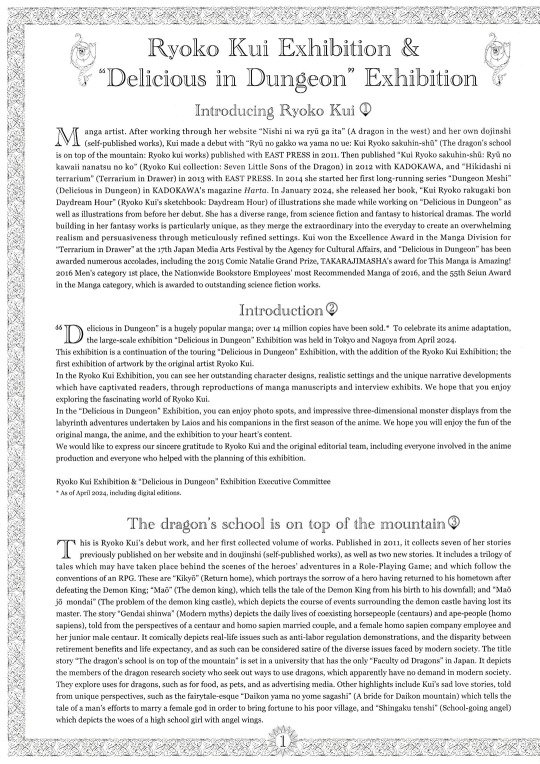
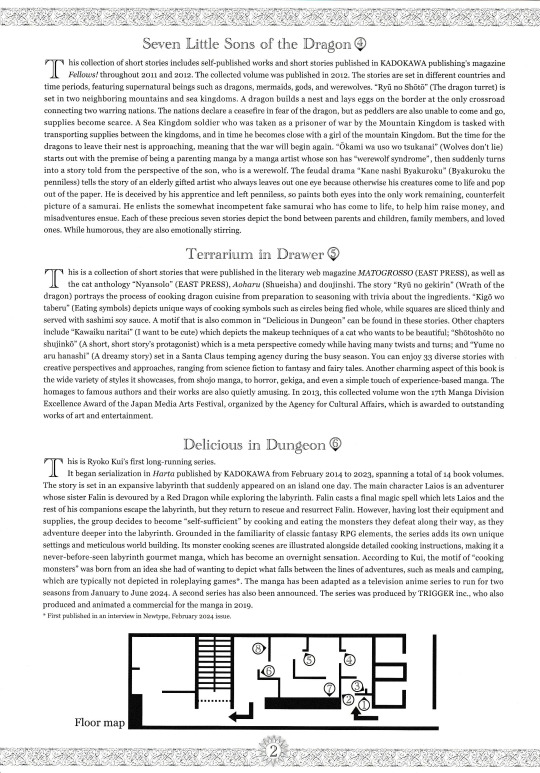




Ryoko Kui Exhibition & ''Delicious in Dungeon'' Exhibition pamphlet
Transcript under the cut
Disclaimer is that I used an image to text website and then proof-read it myself and made corrections where it got the text wrong. There was a few typos in the original text (like writing fied instead of fried) but I kept those in just in case I interpreted something as a typo but it wasn't.
[page 1]
Ryoko Kui Exhibition & "Delicious in Dungeon" Exhibition Introducing Ryoko Kui (1) Manga artist. After working through her website "Nishi ni wa ryū ga ita" (A dragon in the west) and her own dojinshi (self-published works), Kui made a debut with "Ryu no gakko wa yama no ue: Kui Ryoko sakuhin-shu" (The dragon's school is on top of the mountain: Ryoko kui works) published with EAST PRESS in 2011. Then published "Kui Ryoko sakuhin-shu: Ryū no kawaii nanatsu no ko" (Ryoko Kui collection: Seven Little Sons of the Dragon) in 2012 with KADOKAWA, and "Hikidashi ni terrarium" (Terrarium in Drawer) in 2013 with EAST PRESS. In 2014 she started her first long-running series "Dungeon Meshi" (Delicious in Dungeon) in KADOKAWA's magazine Harta. In January 2024, she released her book, "Kui Ryoko rakugaki bon Daydream Hour" (Ryoko Kui's sketchbook: Daydream Hour) of illustrations she made while working on "Delicious in Dungeon" as well as illustrations from before her debut. She has a diverse range, from science fiction and fantasy to historical dramas. The world building in her fantasy works is particularly unique, as they merge the extraordinary into the everyday to create an overwhelming realism and persuasiveness through meticulously refined settings. Kui won the Excellence Award in the Manga Division for "Terrarium in Drawer" at the 17th Japan Media Arts Festival by the Agency for Cultural Affairs, and "Delicious in Dungeon" has been awarded numerous accolades, including the 2015 Comic Natalie Grand Prize, TAKARAJIMASHA's award for This Manga is Amazing! 2016 Men's category 1st place, the Nationwide Bookstore Employees' most Recommended Manga of 2016, and the 55th Seiun Award in the Manga category, which is awarded to outstanding science fiction works. Introduction (2) Delicious in Dungeon" is a hugely popular manga; over 14 million copies have been sold.* To celebrate its anime adaptation, the large-scale exhibition "Delicious in Dungeon" Exhibition was held in Tokyo and Nagoya from April 2024. This exhibition is a continuation of the touring "Delicious in Dungeon" Exhibition, with the addition of the Ryoko Kui Exhibition; the first exhibition of artwork by the original artist Ryoko Kui. In the Ryoko Kui Exhibition, you can see her outstanding character designs, realistic settings and the unique narrative developments which have captivated readers, through reproductions of manga manuscripts and interview exhibits. We hope that you enjoy exploring the fascinating world of Ryoko Kui. In the "Delicious in Dungeon" Exhibition, you can enjoy photo spots, and impressive three-dimensional monster displays from the labyrinth adventures undertaken by Laios and his companions in the first season of the anime. We hope you will enjoy the fun of the original manga, the anime, and the exhibition to your heart's content. We would like to express our sincere gratitude to Ryoko Kui and the original editorial team, including everyone involved in the anime production and everyone who helped with the planning of this exhibition.
Ryoko Kui Exhibition & "Delicious in Dungeon" Exhibition Executive Committee
As of April 2024, including digital editions.
The dragon's school is on top of the mountain (3) This is Ryoko Kui's debut work, and her first collected volume of works. Published in 2011, it collects seven of her stories previously published on her website and in doujinshi (self-published works), as well as two new stories. It includes a trilogy of tales which may have taken place behind the scenes of the heroes' adventures in a Role-Playing Game; and which follow the conventions of an RPG. These are "Kikyō" (Return home), which portrays the sorrow of a hero having returned to his hometown after defeating the Demon King; "Mao" (The demon king), which tells the tale of the Demon King from his birth to his downfall; and "Maō jō mondai" (The problem of the demon king castle), which depicts the course of events surrounding the demon castle having lost its master. The story "Gendai shinwa" (Modern myths) depicts the daily lives of coexisting horsepeople (centaurs) and ape-people (homo sapiens), told from the perspectives of a centaur and homo sapien married couple, and a female homo sapien company employee and her junior male centaur. It comically depicts real-life issues such as anti-labor regulation demonstrations, and the disparity between retirement benefits and life expectancy, and as such can be considered satire of the diverse issues faced by modern society. The title story "The dragon's school is on top of the mountain" is set in a university that has the only "Faculty od Dragons" in Japan. It depicts the members of the dragon research society who seek out ways to use dragons, which apparently have no demand in modern society. They explore uses for dragons, such as for food, as pets, and as advertising media. Other highlights include Kui's sad love stories, told from unique perspectives, such as the fairytale-esque "Daikon yama no yome sagashi" (A bride for Daikon mountain) which tells the tale of a man's efforts to marry a female god in order to bring fortune to his poor village, and "Shingaku tenshi" (School-going angel) which depicts the woes of a high school girl with angel wings.
[page 2]
Seven Little Sons of the Dragon (4) This collection of short stories includes self-published works and short stories published in KADOKAWA publishing's magazine Fellows! throughout 2011 and 2012. The collected volume was published in 2012. The stories are set in different countries and time periods, featuring supernatural beings such as dragons, mermaids, gods, and werewolves. "Ryū no Shōtō” (The dragon turret) is set in two neighboring mountains and sea kingdoms. A dragon builds a nest and lays eggs on the border at the only crossroad connecting two warring nations. The nations declare a ceasefire in fear of the dragon, but as peddlers are also unable to come and go, supplies become scarce. A Sea Kingdom soldier who was taken as a prisoner of war by the Mountain Kingdom is tasked with transporting supplies between the kingdoms, and in time he becomes close with a girl of the mountain Kingdom. But the time for the dragons to leave their nest is approaching, meaning that the war will begin again. “Ōkami wa uso wo tsukanai" (Wolves don't lie) starts out with the premise of being a parenting manga by a manga artist whose son has "werewolf syndrome", then suddenly turns into a story told from the perspective of the son, who is a werewolf. The feudal drama "Kane nashi Byakuroku" (Byakuroku the penniless) tells the story of an elderly gifted artist who always leaves out one eye because otherwise his creatures come to life and pop out of the paper. He is deceived by his apprentice and left penniless, so paints both eyes into the only work remaining, counterfeit picture of a samurai. He enlists the somewhat incompetent fake samurai who has come to life, to help him raise money, and misadventures ensue. Each of these precious seven stories depict the bond between parents and children, family members, and loved ones. While humorous, they are also emotionally stirring.
Terrarium in Drawer (5) This is a collection of short stories that were published in the literary web magazine MATOGROSSO (EAST PRESS), as well as the cat anthology “Nyansolo” (EAST PRESS), Aoharu (Shueisha) and doujinshi. The story “Ryū no gekirin" (Wrath of the dragon) portrays the process of cooking dragon cuisine from preparation to seasoning with trivia about the ingredients. "Kigō wo taberu" (Eating symbols) depicts unique ways of cooking symbols such as circles being fied whole, while squares are sliced thinly and served with sashimi soy sauce. A motif that is also common in "Delicious in Dungeon" can be found in these stories. Other chapters include “Kawaiku naritai" (I want to be cute) which depicts the makeup techniques of a cat who wants to be beautiful; "Shōtoshōto no shujinkō" (A short, short story's protagonist) which is a meta perspective comedy while having many twists and turns; and "Yume no aru hanashi" (A dreamy story) set in a Santa Claus temping agency during the busy season. You can enjoy 33 diverse stories with creative perspectives and approaches, ranging from science fiction to fantasy and fairy tales. Another charming aspect of this book is the wide variety of styles it showcases, from shojo manga, to horror, gekiga, and even a simple touch of experience-based manga. The homages to famous authors and their works are also quietly amusing. In 2013, this collected volume won the 17th Manga Division Excellence Award of the Japan Media Arts Festival, organized by the Agency for Cultural Affairs, which is awarded to outstanding works of art and entertainment.
Delicious in Dungeon (6) This is Ryoko Kui's first long-running series. It began serialization in Harta published by KADOKAWA from February 2014 to 2023, spanning a total of 14 book volumes. The story is set in an expansive labyrinth that suddenly appeared on an island one day. The main character Laios is an adventurer whose sister Falin is devoured by a Red Dragon while exploring the labyrinth. Falin casts a final magic spell which lets Laios and the rest of his companions escape the labyrinth, but they return to rescue and resurrect Falin. However, having lost their equipment and supplies, the group decides to become "self-sufficient” by cooking and eating the monsters they defeat along their way, as they adventure deeper into the labyrinth. Grounded in the familiarity of classic fantasy RPG elements, the series adds its own unique settings and meticulous world building. Its monster cooking scenes are illustrated alongside detailed cooking instructions, making it a never-before-seen labyrinth gourmet manga, which has become an overnight sensation. According to Kui, the motif of "cooking monsters" was born from an idea she had of wanting to depict what falls between the lines of adventures, such as meals and camping, which are typically not depicted in roleplaying games*. The manga has been adapted as a television anime series to run for two seasons from January to June 2024. A second series has also been announced. The series was produced by TRIGGER inc., who also produced and animated a commercial for the manga in 2019.
First published in an interview in Newtype, February 2024 issue.
[Map showing the numbers from each ection from 1 to 8]
[page 3]
"Delicious in Dungeon" Artwork (separate post with pics) Cover illustration draft, vol. 1 Since this was the first volume, I tried out a few different drawings and had the editor and designer choose which ones they wanted, then made small adjustments. I personally liked the top-down draft, and the one of the cooking processes (back cover) the best. But looking back, I sincerely think it's good that we didn't go with those. (Kui)
Cover illustration draft, vol. 2 The format was decided for volume 1. So, volume 2 came together quickly. (Kui)
Cover illustration draft, vol. 3 I thought it might be cool to make the character Chilchuck darker in the foreground, and the background brighter! But it didn't quite work out the way I had imagined. I think it could have been a bit better. (Kui)
Cover illustration draft, vol. 4 I remember that the overall shape of volume 4 came together very quickly. The character Senshi's hands didn't fit nicely, so I moved them backwards and to the side. (Kui)
Cover illustration draft, vol. 5 I thought people might start to think "how many have I bought?" so I wanted to create a slightly different impression with this volume. I decided to put the character right in the center and try putting it together all in blue and green hues. (Kui)
Cover illustration draft, vol. 6 With the Red Dragon defeated, have we reached the halfway point in the story? With this in mind, I thought of how many volumes were left to go, and the number of characters, and decided to pair up the characters Namari and Shuroiro. In hindsight, it would have been fine to have them on one cover each. (Kui)
Cover illustration draft, vol. 7 The image is of focus lines converging on the character Izutsumi. This is the kind of cover, with upside down characters, which I've always wanted to try once(?) I submitted it as a trial, thinking that at this point the cover wouldn't dramatically influence sales. However, in the end, we decided it would be better not to have it upside down. (Kui)
Cover illustration draft, vol. 8 I tried blurring the mushrooms in the foreground, then I accidentally saved over it, and couldn't go back to the original. I remember apologizing that it was probably tacky, when I submitted it. (Kui)
Cover illustration draft, vol. 9 I don't think snake meat is marbled at all, but if it has an unfamiliar look, people might not recognize it as meat… so I made it look like beef to make it easier to understand. (Kui)
Cover illustration draft, vol. 10 I thought it might be interesting to have more than one of the main characters on the cover again, so I added the character Falin. I remember it wasn't badly received, but it still ended up just being Thistle on his own. (Kui)
Cover illustration draft, vol. 11 I wanted this cover to be covered in shiny gold. After I finished it, it didn't have enough color, so I painted the tablecloth green, and it ended up looking like Christmas colors. (Kui)
Cover illustration draft, vol. 12 Up to this point, the covers have featured one of the main characters holding cooking utensils in the foreground and a monster in the background, but I thought it might be interesting to reverse the format just before the final volume, so I drew this cover with that in mind. (Kui)
Cover illustration draft, vol. 13 volume 13 was meant to be the final one, but it was too thick to be published as a single volume, so we decided to split it into two. The question of “so, what should I draw next!?" may be at the forefront of volume 13. (Kui)
Cover illustration draft, vol. 14 I had decided that the final cover definitely needed to have everyone eating together on it, but because I was publishing two books at the same time I was pressed for time, and it was difficult to have a cover with so many characters on it. I also submitted a rough for an illustration that didn't need me to draw any crowds, but such obviously easy ideas are never adopted. (Kui)
TV anime "Delicious in Dungeon" About the ending illustration. I drew these based on the director's instruction "This kinds of pictures." I hardly ever have the chance to draw color illustrations, so it was a valuable experience for me. (Kui)
©Ryoko Kui ©Ryoko Kui,KADOKAWA/Delicious in Dungeon PARTNERS ©Ryoko Kui/ EAST PRESS CO.,LTD. Translation by Kyoto International Manga Museum
[page 4]
Interview to celebrate the opening of the Ryoko Kui Exhibition (7) (separate post) About Delicious in Dungeon: Story making
Q1. Your first long-running series has lasted for about 9 and a half years. Has it been different from your previous experience drawing short stories? A1. Compared to short stories, the series has been easier because the same characters appear each time. But I was surprised to find that I got tired of drawing the same characters too many times.
Q2. You have said before that the overall structure of the story was decided before serialization began, but how much of that had you communicated to your editor? Also, what kind of communication did you have during the series production? A2. The goal was something we discussed and had decided on from the beginning. The goal itself was simple, but the path to get there was more difficult and took longer than imagined.
Q3. Regarding the overall story concept and development, did you write out or put anything down in writing (such as the plot)? A3. I did, but it was simple.
Q4. Did you come up with the dishes based on the monsters you wanted in the story? Or did you come up with the monsters based on the dishes? A4. It depended on the story, but usually the story came first followed by the monsters or food. I feel like that was most often the order.
Q5. As you progressed in drawing the series, what elements of the characters, story, or world expanded or grew in the most unexpected way? A5. Nothing particularly unexpected perhaps. When I used to draw web manga, I tended to think up inconsequential settings. So, from the beginning I tried to restrain myself as much as possible and not expand too much. I was surprised when my editor said "Let's expand it more," in the second half of the series.
Q6. "Delicious in Dungeon" starts with a relatively simple setting, but as the series and the labyrinth exploration continues, the map slowly expands little by little in the readers' minds. It becomes more three-dimensional, revealing the secrets of the world, and taking on a multilayered structure. Are there any sources that you used as a reference, or which influenced you in creating this multilayered structure? A6. A long time ago, when I was working on my personal web manga (fantasy), I drew it however I wanted, thinking that "Only people who can read this will read it," but I regularly received feedback that it was "unreadable", so I tried to make it as easily. accessible as possible.
Q7. The series combines many elements, including "fantasy", "gourmet", "battles", and "puzzle solving", but I think it's also important that it is a "comedy" which makes people laugh. Could you let us know if you have a creative commitment towards depicting humor? A7. My hopes are that I can make it fun for people to read.
[page 5]
About Delicious in Dungeon: Drawing manga
Q1. Please tell us about the drawing tools you currently use, both digital and analogue. A1. In terms of analogue tools, I use a light box, a G pen, a round pen, and a brush pen. And for digital, I use CLIP STUDIO PAINT and a Wacom LCD tablet. Screentone pasting is always done on the computer, so ultimately it all ends up as a digital manuscript. Q2. Do you have any rules or reasons for using digital and analog separately? A2. I'm always looking for ways to draw better and save time, so the exact approach is probably different for almost every chapter. Personally, I feel that analogue methods create more appealing lines, but I feel like digital saves time, so maybe I'll do a digital rough sketch and do the inking by hand… I might have been using a G pen, and maybe I'll try out a turnip pen, or this time I'm short on time so I'll draw it entirely digitally, but with digital I can redo it over and over, so maybe analogue is still faster, and so on and so forth. I'm indecisive in this way and so haven't developed a consistent process.
Q3. I understand that you prepare 3D data for your assistants to draw the backgrounds. What kind of data did you make for "Delicious in Dungeon" ? A3. You could call it 3D, but it's not a proper model, just something to help with the rough sketching. I line up cubes to share the perspective and sense of scale, and they use it as a reference.
Q4. At the beginning of the series, the characters and backgrounds were somewhat simply drawn, and it seems like they became richly detailed over the progression of the story. What was your intention behind using these different styles? A4. It's simply that my technique isn't stable. I thought I'd put a lot of effort in at the start. I remember being confused when my editor asked me to add more in to the drawing, and I wondered "Where…?"
Q5. Thinking about the food, were there any menu illustrations that you were particularly satisfied with, or which you struggled with? A5. I've never liked my own food illustrations. But the times when I read other people's manga and thought "That looks delicious," I think it's been more an influence of the movement, the staging, and the situation than the drawings.
Q6. For the world maps and the terrain of each continent, did you refer to any maps of the real world? I feel like the shape of the 'island' is similar to the shape of Fukuoka Prefecture or Kyushu. A6. I didn't reference any specific geography, but I did try to put thought into things like whether a developed city would be near a river or the sea, and what the coastline would look like. I'm pleased if it feels similar to a real place, because it means my interpretation was pretty accurate.
About Delicious in Dungeon: Other
Q1. Which is your favorite monster? A1. Nightmare.
[page 6]
Q2. I'm sure you have received a lot of feedback from readers in countries and regions outside of Japan. Please tell us if there was anything from them that made you happy, was unexpected, or which made a lasting impression on you. A2. When you play foreign games, there are times when you think "Why did they translate it into Japanese like that?" But having been on the side of having something translated, I've realized some things are unavoidable, or endless, and there are many things that don't matter either way from the author's perspective, so it was interesting.
About Ryoko Kui's short story collections and herself Q1. Dragons are a consistent and important motif in your work. Was there any particular work or experience which inspired this? Also, are there points about drawing dragons which you find interesting or have had to work hard on? A1. It's less about liking dragons, and more that I'm interested in the worlds in which dragons exist. When I draw dragons, the depiction in itself has a sweet feeling to it. I have never had a pet reptile, so I don't have a very good understanding of them.
Q2. Unomiya University in your story "The dragon's school is on top of the mountain" has a Faculty of Dragons, Department of Environmental Studies, and Department of Technology Studies, and a Faculty of Veterinary Medicine. If you were to enroll in the university, which department or faculty would you like to enter? A2. I probably wouldn't be accepted….
Q3. The collection includes a short story staged as an essay manga. Are you a fan of essay manga? Please tell us about any genres of essay manga that you like. A3. I love all kinds of essay manga. I read them often.
Q4. If you were to make your own game, what kind of game would you like to make? A4. I prefer being a player when it comes to games.
Q5. When did you first start drawing illustrations (doodles)? A5. I don't exactly remember when I first drew a picture, but I think I started drawing manga around the fourth or fifth grade of elementary school. in my notebooks and had my friends read them.
Q6. What is the most fun part about drawing manga? A6. Every part is fun and hard in its own way.
Q7. Please tell us if there is anything you "just can't stop no matter what". A7. My procrastination habit.
Q8. Could you please tell us if there's something you want to draw now? A8. I've been working continuously since the serialization, so I'd like to take about 2 to 3 months to just draw whatever I want.
[end]
#Dungeon Meshi#Ryoko Kui#Dungeon Meshi Exhibition#Ryoko Kui Exhibition#Delicious in Dungeon Exhibition#Delicious in Dungeon#Im gonna make the transcript of a few sections their own posts#exhibition
102 notes
·
View notes
Text
Q. 1 Reading 1 Translation

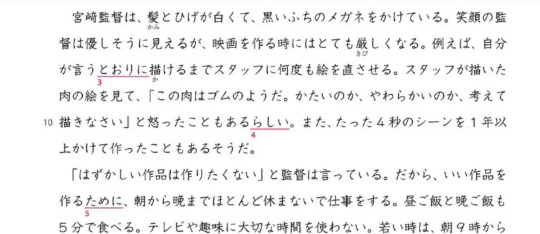

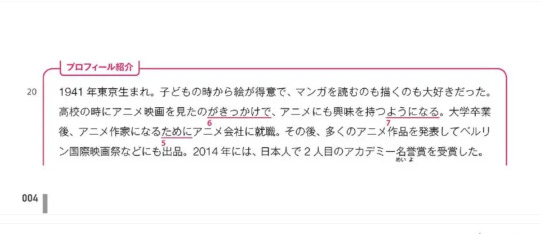
Anime Film Director Miyazaki Hayao
If you speak about Japanese anime film directors, undoubtedly you mean Miyazaki Hayao. "Spirited Away" is especially popular of his works. This was the movie that won an Academy Award in 2003. If you're a person who likes anime, then you have probably seen "Princess Mononoke" and "My Neighbor Totoro" as well.
His anime stories have messages about environmental problems and many things that make adults think. Director Miyazaki has white hair and a white beard and wears glasses with black frames. The smiling face of the director makes him seem nice, but he's very strict when making his films. For example, he makes the staff draw the pictures many times to be exactly as he says.
He looks at the pictures of meat the staff drew, and seems to have many things to be angry about, " this meat looks like gum", "this looks too hard", "This looks too soft", and "Think and draw again!"
Also, it seems that merly a 4 second scene can take more than 1 year to make. The director said, "I don't want to make disgraceful work". Because of that, in order to do good work, from day to night he works without really taking a break. He eats lunch, and dinner in 5 minutes. He also doesn't use his precious time for TV or hobbies. When he was younger, he seemed to work from 9am to 5am the next day.
For that, because of his strict ways with himself, he's made beautiful artistic animation. The pictures and stories of his works are amazing and people will continue to love them forever.
Profile Introduction:
He was born in 1941 in Tokyo. As a child, Miyazaki was good at drawing pictures. He loved reading manga and drawing the images. Because he watched anime in high school, he came to have an interest in anime. After graduating from university in order to become an anime artist, he became employed at an anime company. After that, he presented many works to film festivals like the Berlin Film Festival. In 2014 he became the 2nd Japanese person to receive an Academy Honor Award.
6 notes
·
View notes
Text
Tokyo culture🗼
Tokyo has many museums. In Ueno Park, there is the Tokyo National Museum, the country's largest museum and specializing in traditional Japanese art; the National Museum of Western Art and Ueno Zoo. Other museums include the Artizon Museum in Chūō; the National Museum of Emerging Science and Innovation in Odaiba; the Edo-Tokyo Museum in Sumida, across the Sumida River from the center of Tokyo; the Nezu Museum in Aoyama; and the National Diet Library, National Archives, and the National Museum of Modern Art, which are near the Imperial Palace.
Tokyo has many theaters for performing arts. These include national and private theaters for traditional forms of Japanese drama. Noteworthy are the National Noh Theatre for noh and the Kabuki-za for Kabuki. Symphony orchestras and other musical organizations perform modern and traditional music. The New National Theater Tokyo in Shibuya is the national center for the performing arts, including opera, ballet, contemporary dance and drama. Tokyo also hosts modern Japanese and international pop, and rock music at venues ranging in size from intimate clubs to internationally known areas such as the Nippon Budokan
The Sanja Festival in Asakusa
Many different festivals occur throughout Tokyo. Major events include the Sannō at Hie Shrine, the Sanja at Asakusa Shrine, and the biennial Kanda Festivals. The last features a parade with elaborately decorated floats and thousands of people. Annually on the last Saturday of July, an enormous fireworks display over the Sumida River attracts over a million viewers. Once cherry blossoms bloom in spring, many residents gather in Ueno Park, Inokashira Park, and the Shinjuku Gyoen National Garden for picnics under the blossoms.
Harajuku, a neighborhood in Shibuya, is known internationally for its youth style, fashion and cosplay.
In November 2007, Michelin released their first guide for fine dining in Tokyo, awarding 191 stars in total, or about twice as many as Tokyo's nearest competitor, Paris. As of 2017, 227 restaurants in Tokyo have been awarded (92 in Paris). Twelve establishments were awarded the maximum of three stars (Paris has 10), 54 received two stars, and 161 earned one star.
In popular culture
As the largest population center in Japan and the site of the country's largest broadcasters and studios, Tokyo is frequently the setting for many Japanese movies, television shows, animated series' (anime), web comics, light novels, video games, and comic books (manga). In the kaiju (monster movie) genre, landmarks of Tokyo are usually destroyed by giant monsters such as Godzilla and Gamera.
Tokyo is also a popular foreign setting for non-Japanese media. Some Hollywood directors have turned to Tokyo as a backdrop for movies set in Japan. Postwar examples include Tokyo Joe, My Geisha, Tokyo Story and the James Bond film You Only Live Twice; recent examples include Kill Bill, The Fast and the Furious: Tokyo Drift, Lost in Translation, Babel, Inception, The Wolverine and Avengers: Endgame.
Japanese author Haruki Murakami has based some of his novels in Tokyo (including Norwegian Wood), and David Mitchell's first two novels (number9dream and Ghostwritten) featured the city. Contemporary British painter Carl Randall spent 10 years living in Tokyo as an artist, creating a body of work depicting the city's crowded streets and public spaces.

2 notes
·
View notes
Text

11 | Healing Aloe
Pairing: Tokyo Revengers x Fem!Reader
Wasteland Masterlist
“Okay so now you’re finally ready to acknowledge what happened that day?” Sanzu scoffs.
“I don’t know what you want me to tell you, Sanzu. You fucking murdered that guy!” you remind him.
“Well, it was either him or you. If I didn’t kill him he would’ve just come back eventually,” he explains.
“How can you expect me to thank you for fucking killing someone?” you begin to raise your voice.
“Oh, I’m sorry. Next time I’ll just let you get murdered then,” he rolls his eyes.
“Okay, okay, let’s calm down please,” Kakucho interrupts. “Sanzu, what was your point in asking her about that day?”
“Cause I beat that man to fucking deal, dumbass,” Sanzu snaps. “When I showed up, I had five on my hand and you only had two. So that means beating someone to death with your own two hands awards you three points.”
“Points?” you finally ask. “Why do you keep saying that?”
“Points, days, same thing,” he shrugs.
“But how did Y/N only get two points if she shot that lady twice and killed the guy with her?” Kakucho then interrupts.
“I only killed one of them,” you gulp. “Baji killed the first man.”
Right after you say that, Kakucho grabs Baji’s hand and flips over his wrist.
“Wow, father,” Sanzu smirks. “I wasn’t expecting that from you!”
“Oh please, it was one shot,” Baji scoffs as he pulls back his arm.
“What’re we supposed to do now?” you finally ask. “Are we just going to kill people for the rest of our lives?”
“Dunno,” Sanzu shrugs, smirking slightly at his answer. “Sounds like it.”
“God, you are a fucking sicko!” Baji shakes his head.
“Well, what the hell do you suggest then, priest?” Kakucho asks sarcastically.
“If you’re really asking then I’d say we need to figure out how we got here. How we can go back,” Baji begins, but as he starts to talk all you can think of was that strange-looking deer you had seen outside the jewelry store.
“Y/N, are you okay?” Draken suddenly asks as he touches your shoulder lightly.
“Yeah, I’m fine,” you blink as you bring yourself back to reality. “Hey, have either of you guys seen any deer around here? Or weird-looking animals?”
“Uhh, no…” Sanzu replies, looking at you strangely. “Are you sure you’re alright?”
“Well, our minute is up,” Draken nods as he pats your shoulder. “Time to go, Y/N.”
Sanzu looks over at you and watches closely as you still try to shake yourself back into reality. “You going with those guys?” he then asks.
If you’re being completely honest, Sanzu always scared the crap out of you. Though you’re pretty sure he didn’t mean what he said before about just letting you die next time, you don’t really want to chance things with him right now. Besides, it’s either him or a priest and a sergeant. And when you put it that way, it’s not really much of a competition.
“Yes,” you reply plainly. But before you can stand, Sanzu leans even further over the counter and grabs you by your shirt. Immediately, Baji and Draken bolt over and grab onto your shoulder, not letting Sanzu fully pull you over the counter.
“You’re fucking dead to me, Y/N,” he tells you. “Don’t let me find you again or I’ll end you myself.”
With that, he pushes you back. Luckily, the other two catch you just in time.
“Come on,” Baji nudges you as he looks back at Kakucho and Sanzu. “Let’s go.”
“You better fuckin’ run!” Sanzu laughs wickedly. “I’ll give you all a two minutes head start since I’ve got such a soft spot for Y/N. But you still better run before we come hunting you down!”
When the three of you open the door, you all run as fast as you can. Though your leg hurts like hell, you stumble as far away from Sanzu as fast as you can.
After some time, the three of you make it to the nearby park where you had gone the day before to the festival.
Behind a restroom building, you sink down to the grassy ground and catch your breath. “Shit,” you grumble. “That hurts like a bitch!”
“What the fuck was that?!” Draken then asks you.
“Don’t blame them on me,” you say as breathe heavily. “With me, we would’ve been fucking dead.”
“You really know those freaks?” Baji then asks nervously.
“I used to work with them. It’s not like I chose them to be my friends. Don’t you remember seeing them at the club? Technically, you know them, too, Baji,” you remind him.
“Vaguely,” he shrugs.
“That’s fine,” Draken shakes his head. “It’s probably a good thing they didn’t recognize you, Baji.”
“If everything they said was true, how come you only came here with a three?” you then ask Draken randomly, upon thinking about what Sanzu and Kakucho were telling you. “You were in the war, weren’t you?”
“I was,” he nods, “But maybe that didn’t count. Perhaps because it was something I was forced to do?” he then shrugs. “I mean, think about it, here it’s all on purpose.”
“Well did you hit that biker on purpose?” you then ask him, not to be rude, but to set the record straight.
Baji looks at him with curious eyes as Draken scoffs at your question.
“No,” he tells you. “Are you serious? Do you really think I’d fucking run over some guy because I felt like it?! I told you I went to fucking confess!”
“But you didn’t turn yourself in…”
“Y/N, it had just happened. I didn’t have time to. What are you trying to prove?” he then asks.
“I don’t know,” you then sigh as your posture relaxes. “I’m sorry. I shouldn’t’ve said that. I’m just kind of freaking out that someone like Sanzu is really out there. I mean, he really wants to kill people!”
“We know,” Baji nods as he sits down beside you. “It’s screwed up, but it’s the world we live in now. We’re going to have to figure out a way to survive while also keeping our morals alive.”
Wasteland Masterlist
#tokyo revengers x reader#tokyo revengers x you#tokyo revengers x y/n#tr x you#tr x reader#tr x y/n#tokyo revengers#x fem!reader#x reader#hinatastinygiant#fanfiction series#fanfiction#fanfic#hanagaki takemichi#hinata tachibana#mikey tokyo revengers#draken#baji keisuke#chifuyu matsuno#mitsuya takashi#kisaki tetta#hanma shuji#ao3 fanfic#ao3
9 notes
·
View notes
Text
Obscure Animation Subject #55: Serial Experiments Lain
Originally posted on Twitter on April 15, 2023.
Created by Yasuyuki Ueda, written by Chiaki J. Konaka and directed by Ryūtarō Nakamura, this is a 13-episode miniseries produced by Triangle Staff, and aired on TV Tokyo from July 6 to September 28, 1998.
The series follows Lain Iwakura, an adolescent girl in suburban Japan, and her relation to the Wired, a global communications network similar to the internet. The show is an original idea to the point of it being considered "an enormous risk" by its producer Yasuyuki Ueda.
Ueda had to answer repeated queries about a statement made in an Animerica interview. He stated that Lain was "a sort of cultural war against American culture and the American sense of values we [Japan] adopted after WWII". He later expanded this in numerous interviews.
He created Lain with a set of values he took as distinctly Japanese; he hoped Americans would not understand the series as the Japanese would. This would lead to a "war of ideas" over the meaning of the anime, hopefully culminating in new communication between the two cultures.
When he discovered that the American audience held the same views on the series as the Japanese, he was disappointed. The Lain franchise was originally conceived to connect across forms of media (anime, video games, manga), but due to its failure that was scrapped.
Ueda said in an interview, "the approach I took for this project was to communicate the essence of the work by the total sum of many media products". The scenario for the video game was written first, and the video game was produced at the same time as the anime series.
However, the anime was released first. A dōjinshi titled "The Nightmare of Fabrication" was produced by Yoshitoshi ABe and released in an artbook An Omnipresence in Wired. Ueda and Konaka declared that the idea of a multimedia project wasn’t unusual in Japan, as opposed for Lain.
Despite the show’s confusion to the audience it wanted to appeal to, critics responded positively to the thematic and stylistic characteristics, and it was awarded an Excellence Prize by the 1998 Japan Media Arts Festival for "its question the meaning of contemporary life".
According to Christian Nutt from Newtype USA, the main attraction to the series is its keen view on "the interlocking problems of identity and technology". Nutt saluted Abe's "crisp, clean character design" and the "perfect soundtrack" in his 2005 review of series.
He said that "Serial Experiments Lain might not yet be considered a true classic, but it's a fascinating evolutionary leap that helped change the future of anime." Anime Jump gave it 4.5/5, and Anime on DVD gave it A+ on most criteria with some As for volume 3 and 4.
Lain was subject to commentary in the literary and academic worlds. The Asian Horror Encyclopedia calls it "an outstanding psycho-horror anime about the psychic and spiritual influence of the Internet". It notes that the red spots present in all the shadows look like blood pools.
It also notes the death of a girl in a train accident is "a source of much ghost lore in the twentieth century", more so in Tokyo. Gilles Poitras describes it as a "complex and somehow existential" anime that "pushed the envelope" of anime diversity in the 1990s.
Susan J. Napier in her 2003 reading to The Problem of Existence in Japanese Animation, compared the show to Ghost in the Shell and Spirited Away. According to her, the main characters of the two other works cross barriers; they can cross back to our world, but Lain can’t.
Napier asks whether there is something to which Lain should return, "between an empty 'real' and a dark 'virtual'". Mike Toole named SEL as one of the most important anime of the 90s. Anime Academy gave the series a 75%, but criticized it due to the "lifeless" setting it had.
Michael Poirier of EX magazine stated that the last three episodes fail to resolve the questions in other DVD volumes. Justin Sevakis of Anime News Network noted that the English dub was decent, but that the show relied so little on dialogue that it hardly mattered.
So all in all, this show is one of the weirdest shows out there, but despite being a miniseries, it still has significance thanks to the bizarre nature and sci-fi themes. Not in the levels of Neon Genesis Evangelion or Cowboy Bebop, but still really interesting to go through.

3 notes
·
View notes
Text
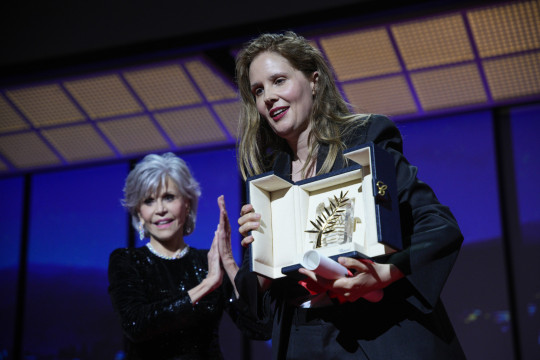
'Anatomy of a Fall' wins Palme d'Or at Cannes Film Festival
CANNES
Justine Triet's “Anatomy of a Fall” won the Palme d'Or at the 76th Cannes Film Festival in a ceremony Saturday that handed the festival's prestigious top prize to a twisty French Alps courtroom drama.
“Anatomy of a Fall,” which stars Sandra Hüller as a writer trying to prove her innocence in her husband’s death, is only the third film directed by a woman to win the Palme d'Or. One of the two previous winners, Julia Ducournau, was on this year's jury.
Cannes' Grand Prix, its second prize, went to Jonathan Glazer’s “The Zone of Interest,” a chilling Martin Amis adaptation about a German family living next door to Auschwitz.
The awards were decided by a jury presided over by two-time Palme winner Ruben Östlund, the Swedish director who won the prize last year for “Triangle of Sadness.” The ceremony preceded the festival's closing night film, the Pixar animation “Elemental.”
The jury prize went to Finnish director Aki Kaurismäki’s “Fallen Leaves," a deadpan love story about a romance that blooms in a loveless workaday world where dispatches from the war in Ukraine regularly play on the radio.
Best actor went to veteran Japanese star Koji Yakusho, who plays a reflective, middle-aged Tokyo man who cleans toilets in Wim Wenders' “Perfect Days.” Wenders' film is a gentle, quotidian character study.
The Turkish actor Merve Dizdar took best actress for the Nuri Bilge Ceylan's “About Dry Grasses.” Ceylan's expansive tale is set in snowy eastern Anatolia about a teacher, Samet (Deniz Celiloğlu), accused of misconduct by a young female student. Dizdar plays as a friend both attracted and repelled by Samet.
“The character I portray in the film is someone who is fighting for her life and she's overcome a lot of difficulties. Under normal circumstances, I would have had to work hard on this character,” said Dizdar.
“I understand what it's like to be a woman in this area of the country,” she continued. “I would like to dedicate this prize to all the women who are fighting to exist and overcome difficulties in this world and to retrain hope.”
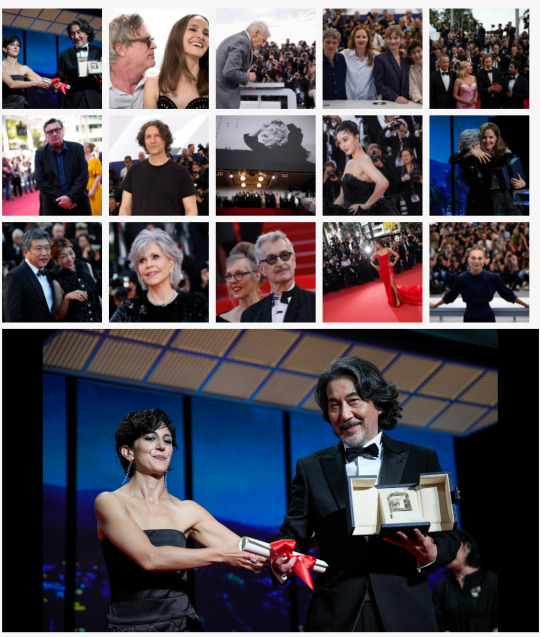
Vietnamese-French director Tràn Anh Hùng took best director for “Pot-au-Feu," a lush, foodie love story starring Juliette Binoche and Benoît Magimel and set in a 19th century French gourmet château.
Best screenplay was won by Yuji Sakamoto for “Monster.” Sakamoto penned Japanese director Hirokazu Kore-eda's nuanced drama, with shifting perspectives, about two boys struggling for acceptance in their school at home. “Monster” also won the Queer Palm, an honor bestowed by journalists for the festival's strongest LGBTQ-themed film.
Quentin Tarantino, who won Cannes' top award for “Pulp Fiction," attended the ceremony to present a tribute to filmmaker Roger Corman. Tarantino praised Corman for filling him and countless moviegoers with “unadulterated cinema pleasure.”
“My cinema is uninhibited, full of excess and fun,” said Corman, the independent film maverick. “I feel like this what Cannes is about.”
The festival's Un Certain Regard section handed out its awards on Friday, giving the top prize to Molly Manning Walker's debut feature, “How to Have Sex.”
Saturday’s ceremony drew to close a Cannes edition that hasn't lacked spectacle, stars or controversy.
The biggest wattage premieres came out of competition. Martin Scorsese debuted his Osage murders epic “Killers of the Flower Moon,” a sprawling vision of American exploitation with Leonardo DiCaprio and Lily Gladstone. “Indiana Jones and the Dial of Destiny,” Harrison Ford’s Indy farewell, launched with a tribute to Ford. Wes Anderson premiered “Asteroid City.”
The festival opened on a note of controversy. “Jeanne du Barry,” a period drama co-starring Johnny Depp as Louis XV, played as the opening night film. The premiere marked Depp's highest profile appearance since the conclusion of his explosive trial last year with ex-wife Amber Heard.
The selection of “Jeanne du Barry” added to criticisms of Cannes for being too hospitable to men accused of abusive behavior.
2 notes
·
View notes
Text
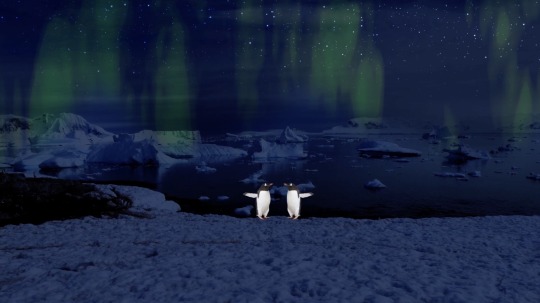
Alucinar, created by Lynne Slater and myself, Margie Kelk, with sound track by David Cardona and Ian Kelk, has recently won awards in two film festivals. It was awarded Best Experimental Short in the spring edition of the Santa Fe Independent Film Festival, and it won Best Combination of Animation and Live Action in the spring edition of the International Cosmopolitan Film Festival of Tokyo.
#internationalcosmopolitanfilmfestivaloftokyo #santafeindependentfilmfestival #alucinar #torontoanimation #canadianstopmotion #penguins #margiekelk #torontoartist
2 notes
·
View notes
Text
Malay: Sapa² ada Twitter jom la Support animasi Malaysia kat Tokyo Anime Awards Festival 2023 Link: https://vote.animefestival.jp/
English:
Whoever has Twitter, let's support Malaysian animation at the Tokyo Anime Awards Festival 2023 Link: https://vote.animefestival.jp/

3 notes
·
View notes
Photo

Studio Ghibli Howl's Moving Castle Journal (Studio Ghibli) Studio Ghibli Howl's Moving Castle Journal (Studio Ghibli) Contributor(s): Studio Ghibli (Author) Publisher: Chronicle Books ISBN: 1797224468 Physical Info: 0.6" H x 7.1" L x 5.0" W (0.55 lbs) 192 pages From legendary animation house Studio Ghibli, this paperback journal celebrates the enchanting world of Howl's Moving Castle, a film about a pivotal friendship between a quiet girl and a mysterious wizard, and their life-changing adventures in a sorcerous world. Complete with full-color artwork on the front and back covers, five interior spreads of concept art, and spot illustrations throughout, this journal is the perfect keepsake for Studio Ghibli fans and animation enthusiasts of all ages. Howl's Moving Castle (c) 2004 Studio Ghibli - NDDMT RARELY SEEN CONCEPT ART: The journal contains spot illustrations throughout, as well as five full-color spreads of rare concept art from the film. GREAT FOR STUDIO GHIBLI FANS: This journal, part of a continuing official partnership with Japanese animation giant Studio Ghibli, captures the nostalgia and magic of the classic Ghibli film Howl's Moving Castle . It's a great gift or self-purchase for animation fans, collectors, artists, and anyone who loves Japanese art, stationery, and pop culture. DISTINCTIVE SCHOOL OR OFFICE SUPPLY: Bring some flair to your school or office supplies with this gorgeous journal. BELOVED STUDIO WITH MASSIVE FAN BASE WORLDWIDE: Miyazaki is often called the Walt Disney of Japan." Six of Studio Ghibli's films received Academy Award nominations in the United States. The Ghibli Museum, Mitaka is a popular destination in Tokyo, seeing about 650,000 visitors a year. INCLUDES: Flexi-bound paperback journal, 5 x 7 inches, 192 lined pages, full-color illustrations throughout, ribbon page marker. Perfect for: - Miyazaki and Studio Ghibli fans of all ages - Animation enthusiasts and collectors - Artists and designers - Fans of Japanese art, stationery, and pop culture - Those looking for collectible, one-of-a-kind stationery Biographical Note: Studio Ghibli is a Tokyo-based animation film studio founded in 1985 by directors Isao Takahata and Hayao Miyazaki. The studio has produced more than twenty feature-length films, many of which have garnered numerous awards and critical acclaim, including My Neighbor Totoro, Kiki's Delivery Service, Princess Mononoke, and the Academy Award(R) winners Spirited Away and The Boy and the Heron. The studio earned Academy Award(R) nominations for Best Animated Feature Film for Howl's Moving Castle, The Wind Rises, The Tale of The Princess Kaguya, When Marnie Was There, and The Red Turtle. Earwig and the Witch was an official selection for the 2020 Cannes Film Festival. Publisher Marketing: From legendary animation house Studio Ghibli, this paperback journal celebrates the enchanting world of Howl's Moving Castle, a film about a pivotal friendship between a quiet girl and a mysterious wizard, and their life-changing adventures in a sorcerous world. Complete with full-color artwork on the front and back covers, five interior spreads of concept art, and spot illustrations throughout, this journal is the perfect keepsake for Studio Ghibli fans and animation enthusiasts of all ages. Howl's Moving Castle (c) Diana Wynne Jones/Hayao Miyazaki/Studio Ghibli, NDDMT RARELY SEEN CONCEPT ART: The journal contains spot illustrations throughout, as well as five full-color spreads of rare concept art from the film. GREAT FOR STUDIO GHIBLI FANS: This journal, part of a continuing official partnership with Japanese animation giant Studio Ghibli, captures the nostalgia and magic of the classic Ghibli film Howl's Moving Castle. It's a great gift or self-purchase for animation fans, collectors, artists, and anyone who loves Japanese art, stationery, and pop culture. DISTINCTIVE SCHOOL OR OFFICE SUPPLY: Bring some flair to your school or office supplies with this gorgeous journal. BELOVED STUDIO WITH MASSIVE FAN BASE WORLDWIDE: Miyazaki is often called the "Walt Disney of Japan." Six of Studio Ghibli's films received Academy Award nominations in the United States. The Ghibli Museum, Mitaka is a popular destination in Tokyo, seeing about 650,000 visitors a year. INCLUDES: Flexi-bound paperback journal, 5 x 7 inches, 192 lined pages, full-color illustrations throughout, ribbon page marker. Perfect for: Miyazaki and Studio Ghibli fans of all ages Animation enthusiasts and collectors Artists and designers Fans of Japanese art, stationery, and pop culture Those looking for collectible, one-of-a-kind stationery
1 note
·
View note
Text
Hedgehog in the Fog(1975)
A beloved Soviet animated cartoon made by Yuri Norstein, the film is considered a masterpiece of animation and has been given a lot of credits for the artistic attention to detail. The timeless appeal and success of the animation is evident by it winning numerous awards for its unique and innovative animation techniques , like First prizes in All-Union Film Festival, Tokyo Art Festival and in a poll conducted by the Tokyo Laputa Animation Festival, it was voted the best animated film in the history of cinema by over 140 animators and critics worldwide.
Unlike Western Studios like disney, Soviet animation, especially from Soyuzmultfilm Studio, Moscow, was renowned for its focus on storytelling, art and the elements of the drawings, rather than making it for the commercial use. The studio became famous for creating films with deep cultural impacts and artistic intelligence, which can be seen in Hedgehog in the fog as well.
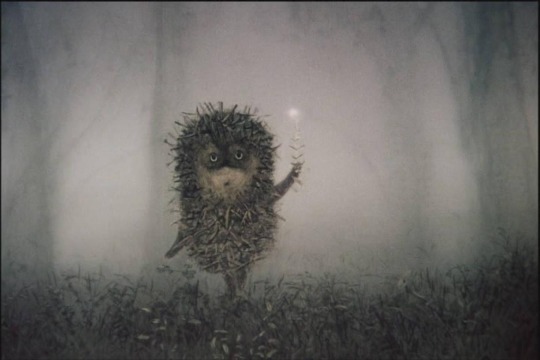
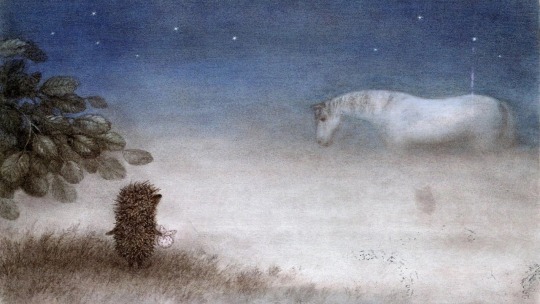
The story begins with Hedgehog setting out one evening to visit his friend, Bear Cub. Since a very long time ago, they drink tea together and stargaze. As Hedgehog walks through the forest, he notices a mysterious white horse standing in the fog. Fascinated and sort of star struck by the horse’s beauty, he decides to go in the fog to get a closer look at it. Inside the fog, the hedgehog is awaited by a strange and creepy animals and objects, including an owl, a dog, and a bat, as well as the river, which becomes a significant moment when Hedgehog is carried away by the current. All of these, sort of interactions are very quick but are very fun to observe. Eventually, our Hedgehog makes his way out of the fog and is met with his friend, the bear cub. While they were doing their "ritual", the hedgehog started thinking about what he had seen in the mysterious, dense fog, about on the beauty of the white horse and his adventure.
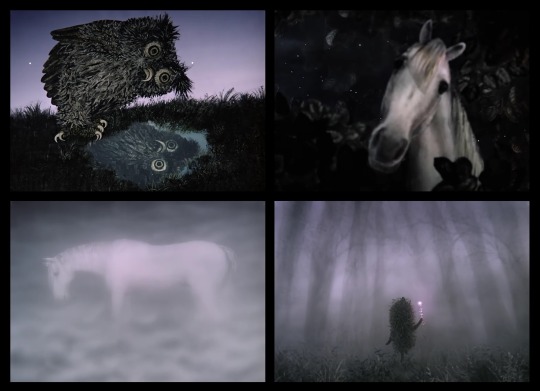
The story ends with a quiet sense of awe and contemplation. The Hedgehog's decision to enter the fog symbolizes human curiosity and a weird attraction towards mystery. The white horse in my opinion, becomes like a metaphor that encourages one to step outside of their comfort zone and they might find strange yet beautiful things while the uncertainty and fear that is a part of life is represented by the fog. Another possible theme of the show could be shown through the importance of friendships and relations, the cub's constant presence and them uniting eventuality shows friendships offers comfort and stability.
Talking about the animation techniques the film primarily uses cut-outs and hand drawn elements. The fog, water ripples and the other "organic" effects were created by hand making the design looks like it was painted. Despite it being 2D, the deliberate pacing and grainy visuals gives it such a stop motion like feel and Norstein taking inspiration from Russian avant-grade art and literature, which often is very focused on minimalism, gave the whole cartoon a sense of timelessness. I think the style of Hedgehog in the fog is not just about the motion of animation being fluid, its about more storytelling and world rich with atmosphere.
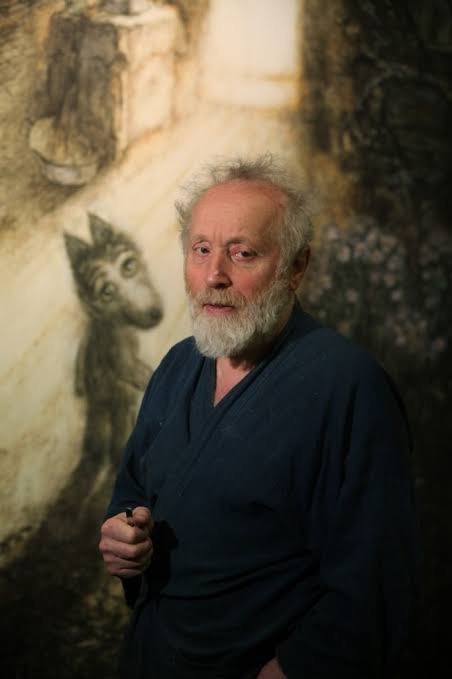
Hedgehog in the fog is more than just an animated short, in my opinion i think it should be seen as a timeless exploration of curiosity, fear and wonder. Through its subtle storytelling and a really immersive world, it leaves room for interpretation, and making the story more about the viewers take on what the scene might depict. The film was first showcased at local and international film festivals, where it quickly gained recognition and was voted the best animated film in the history of cinema by over 140 animators worldwide.
0 notes
Text
crunchyroll.com/news/latest/2024/6/3/tokyo-anime-award-festival-2025-slated-for-march-7-10
0 notes
Text
Nizam A. Razak: Co-founder of Animation Business Company “Monsta”
From ‘Rhoundhay Garden Scene’ by Louis Le Prince being the first motion picture to ‘Workers Leaving the Factory’ by the Lumiere Brothers being the first moving picture and inventors of Cinematography – the Entertainment Industry was born. Since the invention of the Television, people worldwide have looked predominantly toward this form and type of entertainment. For many years now the media and entertainment industry have contributed toward many positive benefits and impacts such as job opportunities, R&D information, bringing communities together, educating and promoting a good lifestyle and wellbeing, and many more.

Along with films and series, animation has become a major part of entertainment. Family-friendly pictures bring the members of a family closer and tighter. Animation can be the first electronic and digital entertainment form for many young children. A popular example is Mickey Mouse by Disney.
Malaysia is considered for animation as an ASEAN hub for its interesting and entertaining animation story. In 2020 Malaysian animation industry was estimated at around $1.6 billion and in 2022 the market size globally is valued at USD 9506.66 which is also expected to reach USD 1970.19 million. Animonsta Studios is a Malaysian animation company that was started by Nizam A. Razak, here let us discuss more about his journey in the animation industry.
Brief about Mohd Nizam Abdul Razak
Nizam A. Razak is a graduate of B.Sc in the stream of film and Animation from Multimedia University and passed out in 2005. After his graduation, he worked as an Executive director at Les Copaque Production for almost 3 years and was also a director for the film GENG Pengembaraan Bermula. Later along with his friends, he founded an animation company called Animonsta Studios in the year 2009 which is now popularly known as Monsta.
Nizam A. Razak worked as the managing director and held the responsibilities of a CEO in the company. He also directed the first 3D animation movie in Malaysia called Geng: The Adventure Begins. This also received an award at the Malaysia Film Festival. Later after the start of Monsta, his business got a breakthrough with the series called BoBoiBoy which was released in 2011. The series was much loved by children and gained positive reviews from parents as well. This made him famous and also brought the international fame and recognition.
The animated series was telecasted on the Disney Channel Asi, TV3, and NTV7. It was also released across 44 other countries which included Brunei, Indonesia, Singapore, and many more. Later followed by BoBoiBoy: The Movie was released in the year 2016 which made a box office hit. This Film won Best Animated Film at the 28th Malaysia Film Festival. Nizam with his creativity announced the continued journey with the film and made BoBoiBoy Galaxy which hit the box office by earning RM30 million in 5 counties and also was nominated in several different film awards like the Florence Film Awards, New York Animation Film Awards, and so on.
Later in 2020 to make to think of machines and their things Nizam announced the release of Mechamato under Monsta, but the film was delayed due to the effect of COVID-19. Then later it was related at the end of 2021 which received huge positive and good reviews and it was also released in around 60 countries like Japan, Portugal, South Korea, and many more. The film was awarded with Anime Fan Award at the Tokyo Anime Award Festival.
Conclusion
Animonsta Studio which is also called Monsta is a company that produces animation-based films that focus on entertaining both children and families. This also provides brand marketing for clients like KFC, Yeo’s, Prego, and more which helps in brand expansion and collaboration marketing strategy. The company also merchandised elements that are their anime character for the consumers. This includes things like toys, cards, apparel, tableware, bottles, food, and bags. Which enhances the interest and attracts the consumer. Thus, Nizam with passion and dedication has established a very well-known company and has been a strong player in the animation and entertainment industry.
Visit More : https://apacbusinesstimes.com/nizam-a-razak-co-founder-of-animation-business-company-monsta/
1 note
·
View note
Text

Oshi no Ko e The First Slam Dunk vincono i premi più importanti del Tokyo Anime Award Festival 2024 Premiati anche Takehiko Inoue, Takeshi Honda, Daiki Nakazawa, YOASOBI. Info:--> https://www.gonagaiworld.com/oshi-no-ko-the-first-slam-dunk-vincono-i-premi-piu-importanti-del-tokyo-anime-award-festival-2024/?feed_id=429681&_unique_id=65c4ec8c15214 #OshinoKo #TAAF2024 #TakehikoInoue #TheFirstSlamDunk #TokyoAnimeAwardFestival2024
0 notes
Text
El after del mundo: Crossing paths of two souls

Humanity ended on the planet Earth and there are nothing but ruins everywhere. El after del Mundo (The World's After) is an animated short film created by Florentina González. After everything was destroyed, there weren't many living creatures around there. The story starts with a soul seeking a stable wifi connection. His luck isn't in his favor but he's persistent. Eventually, he meets with another ghost, we begin to realize their relationship and similar sides as well as opposites. While their environment changes the story develops. The animation and character design are spectacular, the story hooks the viewer to other aspects. In some moments I felt the same vibe with Midnight Gospel, a Netflix-produced animated series. In some ways, the similarity is out there and that also gave me comfort and let me into the story. El after del Mundo does not need any praise from anyone because the awards they get from festivals show its value. You can check Florentina González's Instagram and Vimeo profiles for more information. You can also watch the short film from Vimeo with close captions as well. https://www.youtube.com/watch?v=RRMnwjmSNH0
El after del Mundo - Credits:
Script: Florentina Gonzalez and Luz Marquez Art: Florentina Gonzalez and "Same" Daniela Barella Layouts: Florentina Gonzalez and Florencia Ponticelli Music: Juana Molina Animation: Autour de Minuit Compo: Florentina Gonzalez and Pablo Kondratas
El after del Mundo - Awards:
2022 1. Fantasia International Film Festival - Montréal - Canada 2. Bucheon International Animation Festival - South Korea >> Special Distinction Prize 3. Weird Market - Segovia - Spain 4. Catalonia Fantastic International Film Festival - Sitges - Spain 5. Anima - Cordoba Int. Animation Festival - Córdoba - Argentina >> 3rd Prize for the Best Argentinian Animation + Audience Award 6. Strasbourg European Fantastic Film Festival - France 7. Bit Bang - Buenos Aires - Argentina >> Best Latin American Short Film Award 8. Anim'est International Animation Film Festival - Bucharest - Romania 9. Innsbruck Nature Film Festival - Austria 10. New Chitose Airport International Animation Festival - Japan 11. Armagnac Short Film Festival - Condom - France 12. Uppsala International Short Film Festival - Sweden 13. Etiuda&Anima - Krakow - Poland 14. Alcine - Alcalá de Henares - Spain 15. CutOut Fest, International Animation Film Festival - Querétaro - Mexico 16. Curta Cinema International Short Film Festival - Rio de Janeiro - Brazil 2023 1. Festival Premiers Plans - Angers - France 2. Clermont-Ferrand International Short Film Festival - France 3. Rennes French Animation Film Festival - France 4. Anima - Brussels Animation Film Festival - Belgium 5. Film Maudit 2.0 - Los Angeles - USA 6. African, Asian and Latin American Film Festival - Milano - Italy 7. Tricky Women Animation Film Festival - Vienna - Austria >> Tricky Women/Tricky Realities Award 8. Stuttgart International Festival of Animated Film (ITFS) - Germany 9. Animac - Mostra Internacional de Cinema d'Animació de Catalunya - Lleida - Spain 10. Go Short - Int. Short Film Festival - Nijmegen - The Netherlands 11. Animocje International Animated Films Festival - Bydgoszcz - Poland 12. Regard Saguenay International Short Film Festival - Chicoutimi - Canada 13. Bordeaux European Short Film Festival - France 14. Ciné Filou Festival / Festival Trois Jours Trop Courts - Castres & Albi les Cordeliers - France 15. Tout Court ! - Gisors - France 16. Animafest - Zagreb - Croatia >> Special Award 17. Festival 2ANNAS, Riga International Short Film Festival - Latvia 18. Cinema Jove - Valencia - Spain 19. Los Angeles Latino International Film Festival (LALIFF) - USA 20. Euganea Film Festival - Monselice (Padova) - Italy 21. Short Shorts Film Festival & Asia - Tokyo - Japan 22. Imaxinaria - A Coruña - Spain 23. Baixada Animada, Mostra Ibero-Americana de Cinema de Animação - Rio de Janeiro - Brazil >> Best international film 24. Mecal Pro, the Barcelona International Short and Animation Festival - Barcelone - Spain 25. Contis Film Festival - Contis - France 26. São Paulo Int. Short Film Festival - São Paulo - Brazil 27. Festival du film merveilleux & imaginaire - Paris - France 28. Fantoche - Baden - Switzerland 29. Pixelatl - Guadalajara - Mexico 30. Festival Internacional Jóvenes Realizadores de Granada - Grenade - Spain 31. Auch Short Film Festival - France Images: Screengrabs from the short film Read the full article
0 notes